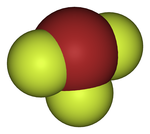Loading AI tools
Chemical compound From Wikipedia, the free encyclopedia
Bromine trifluoride is an interhalogen compound with the formula BrF3. At room temperature, it is a straw-coloured liquid with a pungent odor[5] which decomposes violently on contact with water and organic compounds. It is a powerful fluorinating agent and an ionizing inorganic solvent. It is used to produce uranium hexafluoride (UF6) in the processing and reprocessing of nuclear fuel.[6]
 | |
 | |
| Identifiers | |
|---|---|
3D model (JSmol) |
|
| ChemSpider | |
| ECHA InfoCard | 100.029.211 |
| EC Number |
|
PubChem CID |
|
| UNII | |
| UN number | 1746 |
CompTox Dashboard (EPA) |
|
| |
| |
| Properties | |
| BrF3 | |
| Molar mass | 136.90 g/mol |
| Appearance | straw-coloured liquid hygroscopic |
| Odor | Choking, pungent[1] |
| Density | 2.803 g/cm3 [2] |
| Melting point | 8.77 °C (47.79 °F; 281.92 K) |
| Boiling point | 125.72 °C (258.30 °F; 398.87 K) |
| Reacts with water[3] | |
| Structure | |
| T-shaped (C2v) | |
| 1.19 D | |
| Hazards[4] | |
| Occupational safety and health (OHS/OSH): | |
Main hazards |
Reacts violently with water to release HF, highly toxic, corrosive, powerful oxidizer |
| GHS labelling: | |
    | |
| Danger | |
| H271, H300+H310+H330, H314, H373 | |
| P102, P103, P210, P220, P221, P260, P264, P271, P280, P283, P284, P301+P310, P301+P330+P331, P303+P361+P353, P304+P312, P305+P351+P338+P310, P306+P360, P308+P313, P340, P363, P370+P380 | |
| NFPA 704 (fire diamond) | |
| Safety data sheet (SDS) | http://www.chammascutters.com/en/downloads/Bromine-Trifluoride-MSDS.pdf |
| Related compounds | |
Other anions |
Bromine monochloride |
Other cations |
Chlorine trifluoride Iodine trifluoride |
Related compounds |
Bromine monofluoride Bromine pentafluoride |
| Supplementary data page | |
| Bromine trifluoride (data page) | |
Except where otherwise noted, data are given for materials in their standard state (at 25 °C [77 °F], 100 kPa).
| |
Bromine trifluoride was first described by Paul Lebeau in 1906, who obtained the material by the reaction of bromine with fluorine at 20 °C:[7]
The disproportionation of bromine monofluoride also gives bromine trifluoride:[5]
Like ClF3 and IF3, the BrF3 molecule is T-shaped and planar. In the VSEPR formalism, the bromine center is assigned two electron lone pairs. The distance from the bromine atom to each axial fluorine atom is 1.81 Å and to the equatorial fluorine atom is 1.72 Å. The angle between an axial fluorine atom and the equatorial fluorine atom is slightly smaller than 90° — the 86.2° angle observed is due to the repulsion generated by the electron pairs being greater than that of the Br-F bonds.[8][9]
In a highly exothermic reaction, BrF3 reacts with water to form hydrobromic acid and hydrofluoric acid:
BrF3 is a fluorinating agent, but less reactive than ClF3.[10] Already at -196 °C, it reacts with acetonitrile to give 1,1,1-trifluoroethane.[11]
The liquid is conducting, owing to autoionisation:[6]
Fluoride salts dissolve readily in BrF3 forming tetrafluorobromate:[6]
It reacts as a fluoride donor:[12]
Seamless Wikipedia browsing. On steroids.
Every time you click a link to Wikipedia, Wiktionary or Wikiquote in your browser's search results, it will show the modern Wikiwand interface.
Wikiwand extension is a five stars, simple, with minimum permission required to keep your browsing private, safe and transparent.